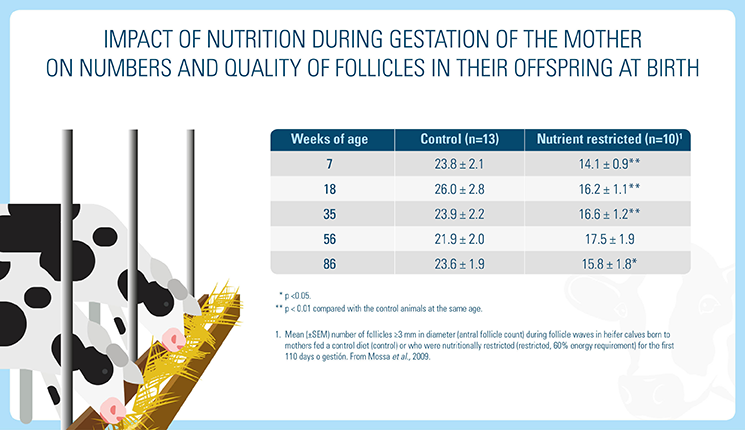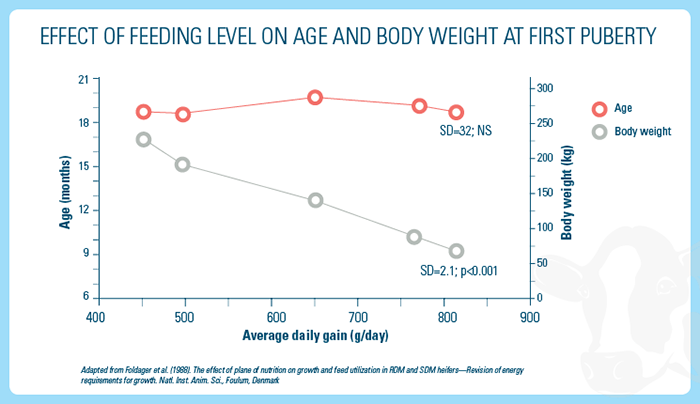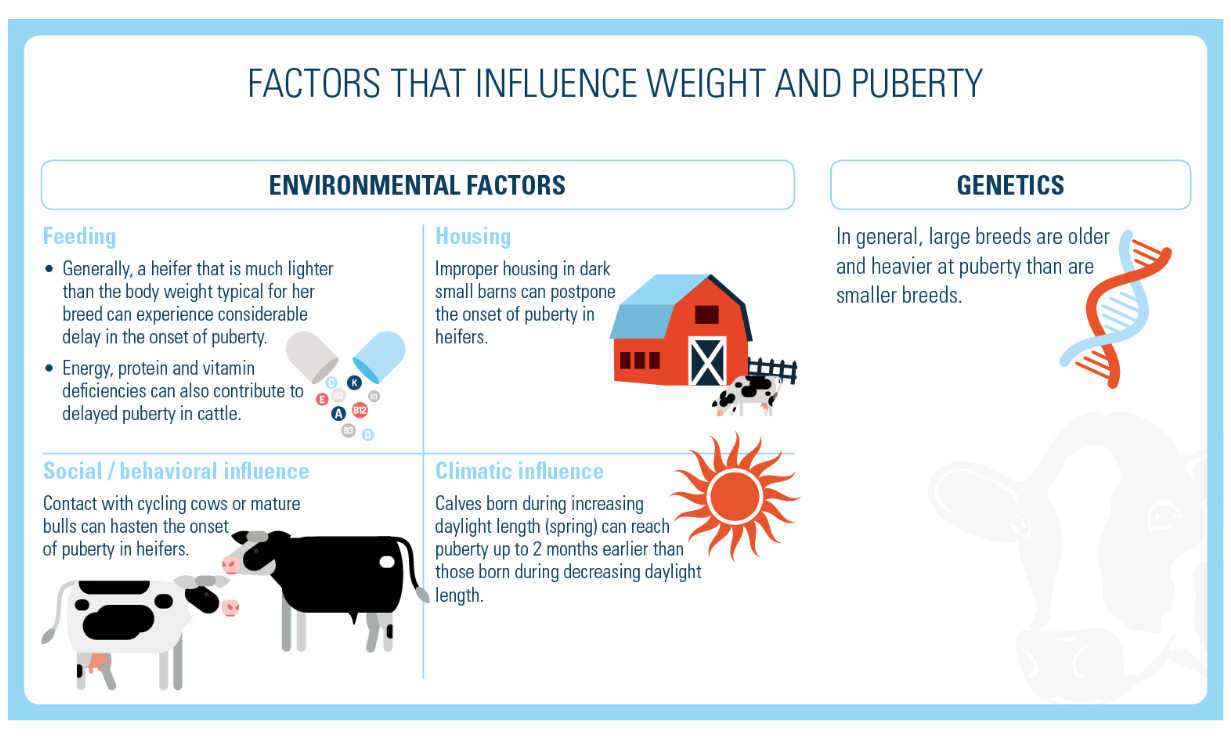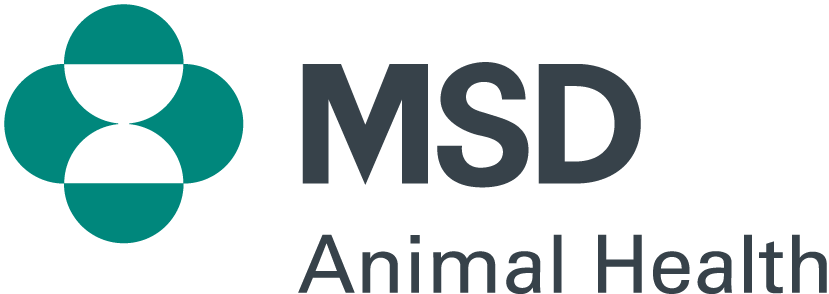

Heifer Reproduction Management
Heifer reproduction management practices have a high influence on their growth, production, fertility, and profitability. Heifers are the future of the dairy herd and should be raised to maximize the herd’s potential.
Nutrition and Management Affect Fertility
Good heifer reproduction management starts before the calves are conceived and continues to the time they enter the milking herd.
Antral follicles of female cows develop during the fetal stage and are already present at birth. Therefore, nutrition and health during gestation of the mother impact the quantity and quality of follicles in their offspring at birth, which contributes to fertility of the new-born later in life1. It has been shown that calves with a large number of high-quality (=size ≥ 3mm) antral follicles in their ovaries at birth have higher pregnancy rates, shorter calving to conception intervals, and fewer artificial inseminations during the breeding season later in life compared to calves with a lower number of high-quality follicles, and similarly, heifers with many high-quality follicles had higher pregnancy rates than those with fewer2.

In new-born calves, proper colostrum management is essential to guarantee the source of immunity. Heifers need to have access to clean feed and water, and the aim is to reach the target breeding weight at the appropriate time that allows for earlier breeding and calving dates.
The onset of puberty in dairy heifers is dependent on weight and usually occurs in Holsteins at around 370 kg of weight. When average daily gain (ADG) is around 800 grams per day, puberty will start around 15 months of age. When it is around 600 grams per day, puberty will be delayed for five months and occur at 20 months of age3.
Housing for Heifer Management
Once calves are born, a healthy environment with proper facilities, water, high quality feed, daily observations, and health care must be ensured. This kind of attention should extend beyond the baby calves and remain in place until the age of first calving.
Fertility and Breeding
Fertility and breeding management of heifers are essential for farm profitability. Healthy heifers must be reared and calved in a suitable manner and produced on a regular basis. Heifer fertility management and planning is a critical component of the age at first calving.
Onset of puberty is dependent on bodyweight: the higher the ADG, the earlier onset of puberty

Long periods of nutritional deficiency and severe or infectious diseases that can cause abortion will compromise development with long-term adverse consequences. Delayed first calving, at more than 30 months of age, is associated with poor survival3.
Monitoring and Planning
Improved monitoring of growth at regular intervals on dairy units would aid producers to optimize their heifer management. To be able to check growth and fertility performance of the heifers during the weaning to breeding period, it is fundamental to regularly monitor their key parameters:
- The growth and weight target before and at the start of artificial insemination. Monitoring growth rates and feed should be adjusted accordingly.
- The percentage of successfully bred heifers under 15 months of age. It should ideally be 100%, but the minimum requirement is above 90%. It depends on heat detection rate, conception rate, and pregnancy rate.
- The percentage of successfully calved heifers before or at 24 months of age. The minimum requirement is above 90%.
This data should be used to analyze the situation, identify risk factors, and change management. Heifer reproduction technologies such as estrus synchronization and sexed semen can be used but unless heifers have been previously well-managed, the success rates may be unacceptably low.
Induction of Cyclicity in Heifers Around Puberty
Factors that Influence Reaching Puberty In heifers, puberty is reached at the time of first ovulation, which is dependent on body weight. The onset of puberty occurs around 15 months, depending on many factors such as growth rate, breed, management, and climatic conditions.

The golden rules of Heifer reproduction management are:
- To correct feeding and management failures before the induction of estrus is attempted.
- To examine the reproductive tract of the heifers selected for induction, and especially those with delayed puberty, in order to eliminate cases of developmental anomalies within the reproductive tract (freemartinism, white heifer disease, ovarian aplasia).
Traditionally, PMSG or progestagen-based induction/synchronization programs have been used for induction of puberty in heifers.
- Evans, Alexander & Mossa, Francesca & Walsh, Siobhan & Scheetz, Danielle & Jimenez-Krassel, Fermin & L H Ireland, J & W. Smith, G & J. Ireland, J. 2012. Effects of Maternal Environment During Gestation on Ovarian Folliculogenesis and Consequences for Fertility in Bovine Offspring. Reprod Dom Aanim 47 (Suppl.4), 31-37.
- Mossa F, Walsh SW, Butler ST, Berry DP, Carter F, Lonergan P, Smith GW, Ireland JJ, Evans ACO, 2012: Low numbers of ovarian follicles ‡ 3 mm in diameter are associated with low fertility in dairy cows. J Dairy Sci 95, 2355–236.
- Wathes, D Claire & Pollott, Geoff & Johnson, Kate & Richardson, H & S Cooke, J. (2014). Heifer fertility and carry over consequences for life time production in dairy and beef cattle. Animal: an international journal of animal bioscience. 8. 1-14.

